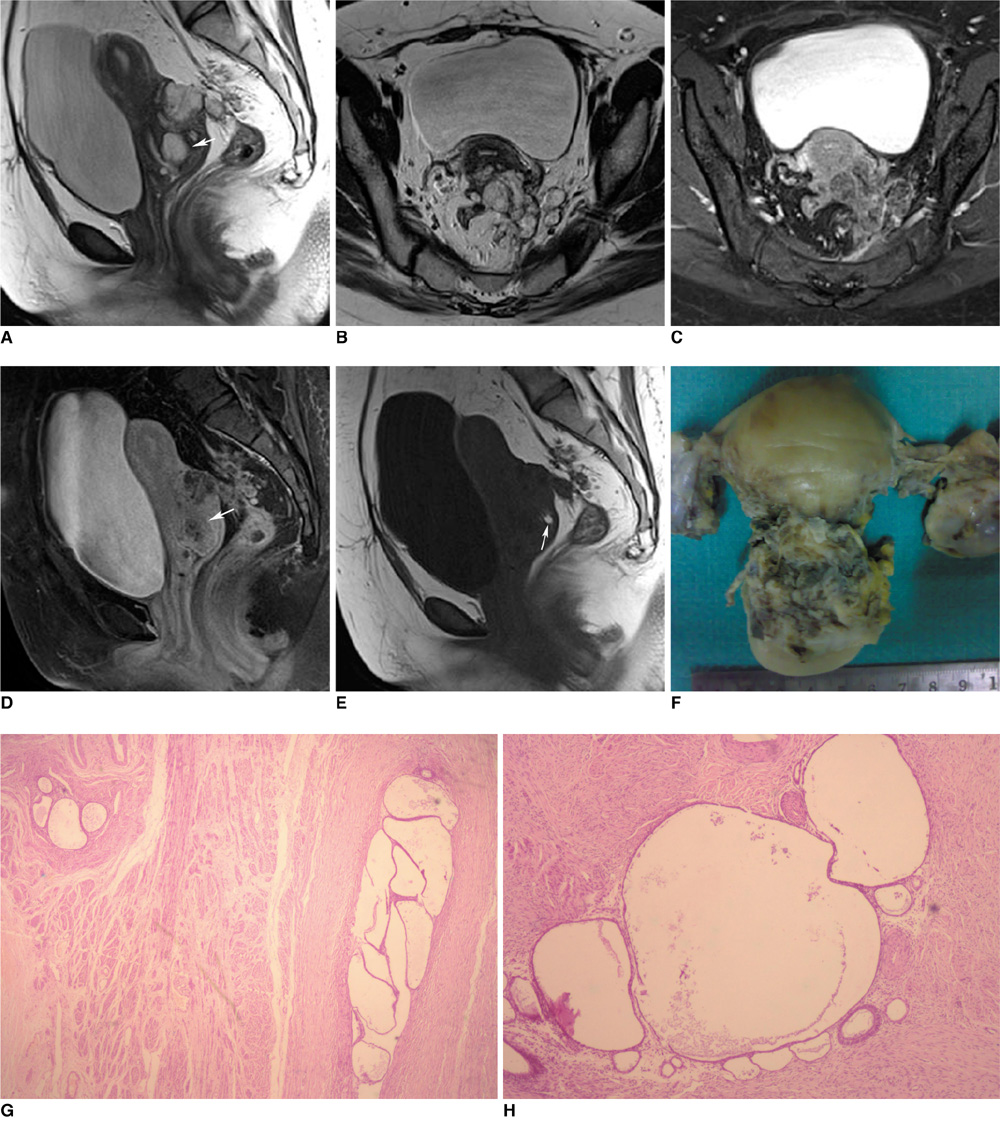Korean J Radiol.
2010 Aug;11(4):476-479. 10.3348/kjr.2010.11.4.476.
MRI Appearance of Florid Cystic Endosalpingiosis of the Uterus: a Case Report
- Affiliations
-
- 1Department of MRI, Rajiv Gandhi Cancer Institute & Research Centre, India. s_taneja1974@yahoo.com
- 2Department of Histo-Pathology, Rajiv Gandhi Cancer Institute & Research Centre, India.
- 3Department of Gynaecology and Oncology, Rajiv Gandhi Cancer Institute & Research Centre, India.
- 4Department of Pathology, Rajiv Gandhi Cancer Institute & Research Centre, India.
- 5Department of MRI, Rajiv Gandhi Cancer Institute & Research Centre, India.
- KMID: 984903
- DOI: http://doi.org/10.3348/kjr.2010.11.4.476
Abstract
- Endosalpingiosis is a non-neoplastic proliferation of ectopic tubal epithelium. It may be found incidentally or the patients may present with chronic pelvic pain. It may resemble a gynecologic malignancy on imaging findings and clinicians and radiologists should be aware of this benign entity to render a correct diagnosis and to avoid over-treatment. We report here the MR imaging appearance of a case of florid cystic endosalpingiosis.
MeSH Terms
Figure
Reference
-
1. Clement PB, Young RH. Florid cystic endosalpingiosis with tumor like manifestations: a report of four cases including the first reported cases of transmural endosalpingiosis of the uterus. Am J Surg Pathol. 1999. 23:166–175.2. Bazot M, Vacher Lavenu MC, Bigot JM. Imaging of endosalpingiosis. Clin Radiol. 1999. 54:482–485.3. Zinsser KR, Wheeler JE. Endosalpingiosis in the omentum: a study of autopsy and surgical material. Am J Surg Pathol. 1982. 6:109–117.4. deHoop TA, Mira J, Thomas MA. Endosalpingiosis and chronic pelvic pain. J Reprod Med. 1997. 42:613–616.5. Cil AP, Atasoy P, Kara SA. Myometrial involvement of tumor-like cystic endosalpingiosis: a rare entity. Ultrasound Obstet Gynecol. 2008. 32:106–110.6. Tutschka BG, Lauchlan SC. Endosalpingiosis. Obstet Gynecol. 1980. 55:S57–S60.7. Young RH, Clement PB. Müllerianosis of the urinary bladder. Mod Pathol. 1996. 9:731–737.8. Cajigas A, Axiotis CA. Endosalpingiosis of the vermiform appendix. Int J Gynaecol Pathol. 1990. 9:291–295.9. Shim SH, Kim HS, Joo M, Chang SH, Kwak JE. Florid cystic endosalpingiosis of the uterus: a case report. Korean J Pathol. 2008. 42:189–191.10. Heatley MK, Russell P. Florid cystic endosalpingiosis of the uterus. J Clin Pathol. 2001. 54:399–400.
- Full Text Links
- Actions
-
Cited
- CITED
-
- Close
- Share
- Similar articles
-
- Multicentric Florid Cystic Endosalpingiosis in Different Anatomical Spaces: A Case Report
- Florid Cystic Endosalpingiosis of the Uterus: A Case Report
- Sonographic Appearance of Endosalpingiosis
- Endosalpingiosis in Postmenopausal Elderly Women
- CT and MR Imaging Findings of Cystic Adenomyosis of the Uterus: Report of Three Cases


